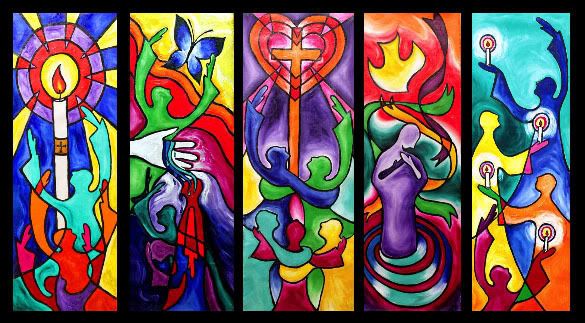 A sermon for Ash Wednesday
A sermon for Ash Wednesdayby Laura Gentry
Tonight marks the start of our Lenten season. You will soon be invited to come forward to receive the cross of ashes upon your forehead with those hard-hitting words “Remember that you are dust and to dust you shall return.” We are dust.
I was recently having a conversation with a person who is struggling with some addictions. Though he’s kicked one, he still has a few others to work on. “I don’t want to be that guy,” he told me. He can see himself clearly enough to know that he doesn’t want to go on being the person he’s been. In his own way, he knows that he is dust.
Each of us faces a struggle of this sort. We see our lives and sure we see our good points but if we look hard enough we have to say: I don’t want to be that person. I don’t want to be the person who walks so far from God, who is so self-centered and doubtful and helpless. But the truth is that’s what we are. We are dust.
And the message of Ash Wednesday is that it okay to be dust—to be a broken person in desperate need of help. That is why tonight we freely confess our sinfulness, our brokenness, and beg God for redemption.
Ashes in ancient times were used to show sinfulness. If you’d see a guy walking around with a cloud of gray ash so thick you couldn’t even recognize him, you would know that he was repenting for something. It was a ritualized way of showing the foulness of our sin, of our desperate need for God’s redemption.
But repentance is not so outwardly demonstrated these days, except for Ash Wednesday and you’ll be glad to know that we don’t dump a whole bucket of ash on your head like in olden days. We simply give you an ashen cross—made from the burnt palms of last year. We place the ash in the middle of your forehead. And this mark reminds you and everyone else that you are dust and to dust you shall return.
Lent invites us to spend the next 40 days repenting and engaging in prayer, fasting and almsgiving to prepare for Easter. These specific Lenten practices were devised for the purpose of putting you in communion with God.
And that’s what we want most of all. Our souls thirst for God. Our hearts are restless long to draw nearer God. We don’t want to be these people we are, who walk so far away from God. We want to be held in the heart of the divine. We want healing for our dustiness. And the scripture says to us that we are to return to God with our whole hearts.
We may have let a lot of Lenten seasons go by in the past, where we didn’t do much to draw near to God. We didn’t pray, fast or give alms and then wondered why Lent didn’t do anything for our spiritual life. This year, I urge you to seize this opportunity to turn to God with all your heart, to do whatever spiritual disciplines YOU need in order to put yourself in communion with God. Come to the Wednesday night sessions where you will learn practical, historically based practices that will help you do just that.
I was recently having a conversation with a person who is struggling with some addictions. Though he’s kicked one, he still has a few others to work on. “I don’t want to be that guy,” he told me. He can see himself clearly enough to know that he doesn’t want to go on being the person he’s been. In his own way, he knows that he is dust.
Each of us faces a struggle of this sort. We see our lives and sure we see our good points but if we look hard enough we have to say: I don’t want to be that person. I don’t want to be the person who walks so far from God, who is so self-centered and doubtful and helpless. But the truth is that’s what we are. We are dust.
And the message of Ash Wednesday is that it okay to be dust—to be a broken person in desperate need of help. That is why tonight we freely confess our sinfulness, our brokenness, and beg God for redemption.
Ashes in ancient times were used to show sinfulness. If you’d see a guy walking around with a cloud of gray ash so thick you couldn’t even recognize him, you would know that he was repenting for something. It was a ritualized way of showing the foulness of our sin, of our desperate need for God’s redemption.
But repentance is not so outwardly demonstrated these days, except for Ash Wednesday and you’ll be glad to know that we don’t dump a whole bucket of ash on your head like in olden days. We simply give you an ashen cross—made from the burnt palms of last year. We place the ash in the middle of your forehead. And this mark reminds you and everyone else that you are dust and to dust you shall return.
Lent invites us to spend the next 40 days repenting and engaging in prayer, fasting and almsgiving to prepare for Easter. These specific Lenten practices were devised for the purpose of putting you in communion with God.
And that’s what we want most of all. Our souls thirst for God. Our hearts are restless long to draw nearer God. We don’t want to be these people we are, who walk so far away from God. We want to be held in the heart of the divine. We want healing for our dustiness. And the scripture says to us that we are to return to God with our whole hearts.
We may have let a lot of Lenten seasons go by in the past, where we didn’t do much to draw near to God. We didn’t pray, fast or give alms and then wondered why Lent didn’t do anything for our spiritual life. This year, I urge you to seize this opportunity to turn to God with all your heart, to do whatever spiritual disciplines YOU need in order to put yourself in communion with God. Come to the Wednesday night sessions where you will learn practical, historically based practices that will help you do just that.
Lent is too important to sit out. We must dive right in and trust that God will work through our feeble, dusty efforts and will lift us to the joy divine. Amen.

The ceramic cross pendants were made by Pastor Laura Gentry. Each parishioner was given one as they recived the mark of ashes upon their forhead to serve as a reminder that we are dust and to dust we shall return.







